MEASURE 1:
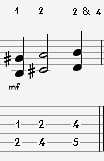
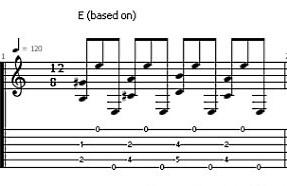
Chapter 11
BOB DYLAN'S GREATEST MISTAKE
Eventually I guess he did get a few songs published, but his REAL genius was in his early fingerpicking. He should have stuck with it instead of going electric--he might have amounted to something.
The arrangement here is inspired by Dylan's lovely rendition of this traditional blues on his second album, Freewheeling Bob Dylan. I've used it as a vehicle to return to BACKPICKING (remember Van Ronk's arrangement of John Hurt's SpikeDriver's Moan?). We'll sort of flip a twelve bar blues upside down with sweet, repetitive patterns reminiscent of the licks played on that record date by famed folky session guitarist Bruce Langhorne.
Langhorne only had something like three fingers or so on his left hand. He sure made the most of them! He was a terrifically tastful player (check out his playing behind Tom Rush on the tune Urge For Going, from the same era).
So there was Bruce Langhorne, playing lovely mobile sliding sixths while Dylan crooned away incessantly about some bohemian siren--hard to believe this song was once a traditional blues....
Oh well...this is a very valuable backup pattern for guitarists. Not just for this song, but for other songs in E and A as well.
Remember the modular, repetitive structure of Rock Me Baby? Same thing here!
Let's start with the E module:
MEASURE 1:


These are triplets, but infinitely gentler than in our Lightnin' Hopkins Blues. More predictable, too.
Beat 1: Make a simple E7 with Left Middle on 5th string second fret,
Left Index on 3rd String first fret.
Play them, then play 1st string
open, then the 6th string bass. That's triplet numbero uno.
Beat 2: Move to the next chord form by sliding Left index one fret, and
adding Left ring on 5th string, fourth fret.
Beat 3: Move the index up again, now to the fourth fret--and make a
form that looks like the one from Beat 1, but on these higher frets.
Beat 4: Repeat Beat 2.
MEASURE 2:
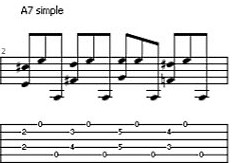
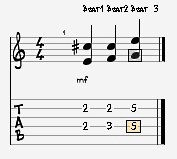
Beat 1: Left Ring on 2nd string, second fret, Left Middle on 4th
string, second fret. Play 'em. Then play 1st string, then 5th.
Beat 2: Now Left Index on 2nd string, third fret. Left Middle on 4th
string, fourth fret.
Beat 3: Same position as Beat 1, but on fourth and fifth frets.
Beat 4: Same as Beat 2.
These two patterns will play over and over in this piece, as E7 and A7 patterns.
MEASURE 3:
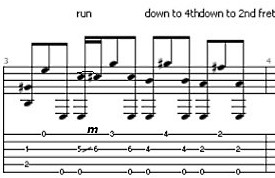
Beat 1: The identical triplet as in Measure 1, Beat 1.
Beat 2: Slide Left Middle from the fifth to the sixth fret on the 3rd
string, then catch the 1st string on the fifth fret with Left Index.
End all these triplets with a 6th string bass.
Beat 3: Middle on 3rd string fourth fret, followed by Ring on the 1st
string fourth fret.
Beat 4: Middle--3rd string second fret, then Ring 1st string second fret.
Good news!
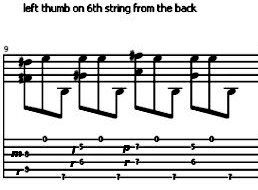
ya know, I really hated to do this to you.
You students
trusted me,
and now I'm giving you this Left Thumb-twister.
Oh well. It's so pretty it's worth practicing a lot!
Leave the Left Thumb on 6th string, Seventh fret all through this measure!
Beat 1: Ring on 5th string, ninth fret, together with Middle on 3rd
string eighth fret. Then open 1st string for middle of triplet.
End
the triplet by playing the 6th string (where your Left thumb lies on
the seventh fret, of course).
Beat 2: [Still leaving Left Thumb on] shift off Ring and Middle, and
put Middle on 4th string, sixth fret.
At same time put Index on 2nd
string, fifth fret. Play 'em. Again, open 1st string, then 6th string
seventh fret.
Beat 3: Now shift to Ring on 4th string, Pinky on 2nd string, both on
seventh fret.
Repeat 1st string open, then 6th string seventh fret to
complete the triplet .
Beat 4: Same as Beat 2.
Fortunately,
That's all!
Practice these selected measures, then try the whole piece. It really has a sweet sound!
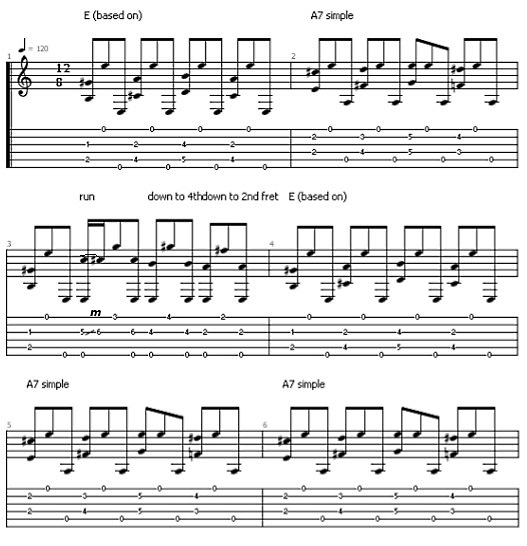
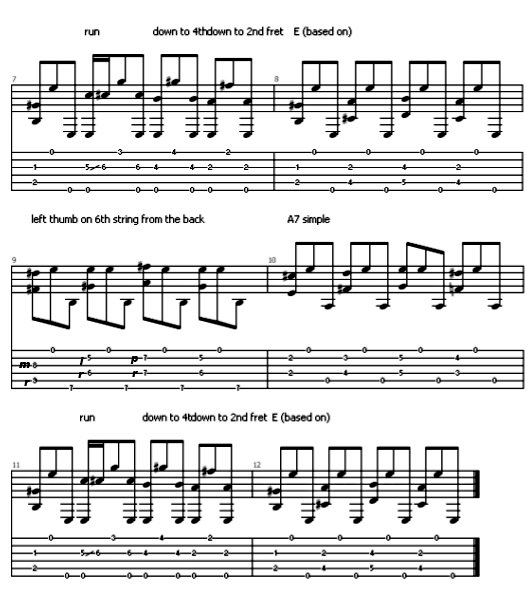
This piece is a great intro to chords that move up the neck. Dylan played this on his first album, and dedicated it to a Boston graphics artist who had taught it to him (and probably scored lots of freelance album cover and art work from the resulting publicity).
Then Dave Van Ronk started playing another version of this tune, since Rev. Gary Davis had shown it to someone else--under the title BABY LET ME LAY IT ON YOU. I remember Van Ronk performing it one afternoon at the 1964 Newport Folk Festival--and the crowd ate it up.
My Dylanized version here is a bit simpler than Van Ronk or Jorma would play, but lots of fun. If you could play this even half decently in 1965, you were almost guaranteed a Saturday night date--or didn't need one. It's still rather impressive!
Measures 1 and 2 are straightforward.
The C formation in Measure 3 (keep your Left Pinky on the 1st string third fret) SLIDES UP THREE FRETS--all in one piece. I call this an "Eb", but all you need to remember is that it's a C up three frets (fourth to Sixth frets):
MEASURE 4:
![]()

Now that you've slid the C chord (with pinky) up three frets, don't pick up any of your Left hand fingers--that is, until you play the Bass on Beat 3. At that time alternate your Left Ring (in the normal fashion for a C chord) to the 6th string.
On the off-beat of Beat 4 you'll switch to another transplanted chord-- the normal D chord moved up five frets, to become a "G". Play the 2nd string.
Now the fun begins:
These next measures are not hard, just disorienting the first few times. You'll be moving from Measure Five's "G" form (it looks like a D), to a fuller version of the D form we used in Mance Lipscomb's Spoonful.
I call it this the Broonzy D. To make matters worse, it's derived from an "A" chord form.

G--"d" up 5

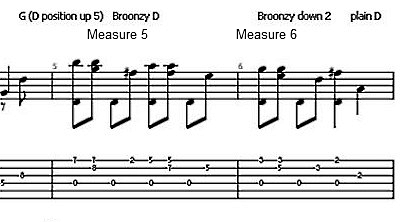
MEASURE 5--keep the bass only the 4th string:
Beat 1: Use the normal D, up five frets. Play the 1st and 4th strings
together, then pluck strings 1 & 2 at the same time.
Beat 2: After the bass, switch to the "Broonzy D" for the off-beat.
It's on frets five and seven. Play 2nd string.
Beat 3: Play 1st and 4th strings simultaneously. Then pluck strings 1
& 2 on the off-beat.
Beat 4: Play the bass note again, then switch chords again by SLIDING
the Broonzy D down TWO frets to the Third and Fifth frets. Play the
2nd string.
MEASURE 6--Still holding the Broonzy D on the Third & Fifth frets? Now
it's actually a C chord.
Beat 1: Play 1st and 4th strings together, then pluck strings 1 & 2
simultaneously.
Beat 2: Move to an old-fashioned D chord by the off-beat here.
Beats 3 & 4: The bass'll alternate between the 4th and 3rd strings by this time.
No more crazy moves!
The rest is smooth sailing. Don't forget to lift off the finger on the 1st string for Measure 7, Beat 3 (to get the open 1st string on the off-beat).
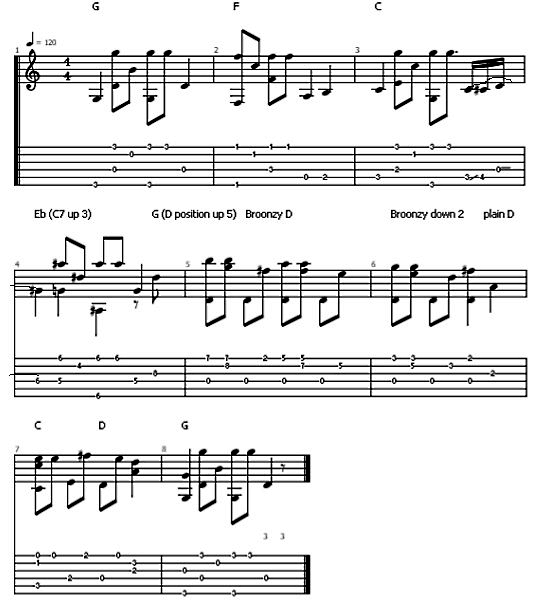
| Back to the Table Of Contents | Trouble reading tablature?: Tablature Help Here |
More info/contact Andy: www.andypolon.com